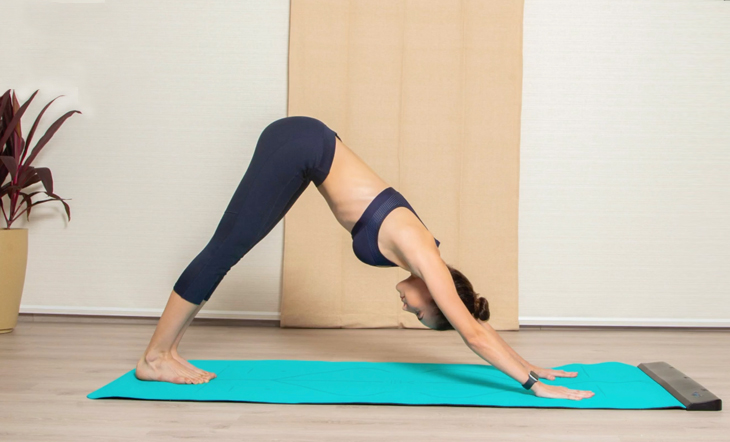As more and more people begin to do yoga in the comfort of their own homes, technology is increasingly used in today’s home yoga practices. But have you heard of intelligent yoga mats?
You’re probably familiar with using your phone to use a yoga app, or playing your favorite yoga video on your TV. But technology in yoga is going even further these days, with the introduction of smart yoga mats. Yes, smart as in electronic.
These smart, electronic yoga mats are popping up everywhere. Whether you’re intrigued or repelled, we’re here to tell you what they are, how you use them, and if it’s worth investing in an intelligent yoga mat.
What Is an Intelligent Yoga Mat?
Nearly 30 million people in the United States practice yoga, and the amount of people practicing at home continues to increase. Doing yoga at home is a great and accessible way to incorporate yoga into your life without hassle.
While doing yoga at home does provide certain benefits (hello, doing yoga in your underwear!), you lose the benefit of having a real teacher there to correct your posture. Smart yoga mats aim to fix that.
Ultimately, an intelligent yoga mat is an electronic yoga mat that responds to pressure to give you feedback on your movement and alignment.
Several smart yoga mats, such as SmartMat and the YogiFi smart mat, offer their services as a “personalized yoga coach.” Think of it sort of like a Peloton, but for yoga.
With sensors in the mat that track where you’re placing pressure, their mats use artificial intelligence to provide real-time guidance to help you shift your alignment.
The mats can also provide tracking of your sessions and report performance after you’re done.
Image: YogiFi AI Powered Smart Yoga Mat
How Do You Use an Intelligent Yoga Mat?
You use an intelligent yoga mat just like any other yoga mat, but respond to voice prompts to shift your position into proper alignment.
Generally, before using the mat, you’ll go through a physical calibration process so that the mat can learn about your body, your needs, and your yoga abilities. Then you just get posing!
Most electronic yoga mats will connect with both Apple and Android phones or tablets. Several electronic yoga mats also come with an app that provides classes, in addition to feedback and session summaries.
For example, the YogiFi smart mat includes personalized workout plans. And, if you’re someone who likes to feel like you’re achieving something concrete, the app also awards badges for things like daily practice or pose improvement.
Some smart yoga mats, like the TERA mat, use lights, rather than voice cues, to gently correct your poses.
In fact, the TERA mat uses the lights, rather than voice instruction, to guide your practice in the first place, and then uses sensors and lights to correct your pose. If you’re not interested in a voice interrupting your session, this may be a better option.

Image: TERA intelligent fitness mat
Are Intelligent Yoga Mats the Next Big Thing? Let’s Explore the Pros + Cons of Electronic Yoga Mats:
High tech yoga mats are undoubtedly an exciting innovation in the yoga world. But there are definitely some pros and cons that may make or break the intelligent yoga mat as the best choice for you and your yoga practice.
Pro #1. Provide Instruction at Home
The mats offer personalized instruction in your own home. This makes it easier to incorporate feedback into your at-home sessions, and provides more privacy.
So if you’re nervous about trying out Crow Pose or Headstands in a public studio, smart mats could be a good way to learn new poses, in the privacy of your own home.
Pro #2. They’re Portable
Some smart yoga mats, like SmartMat, don’t require internet, so you can do your yoga anywhere. Both the SmartMat and the YogiFi mat can be rolled up and transported.
Pro #3. They’re Pretty
The TERA mat doubles as home decor! The mat is made from carpet-like material, so you can just leave it in your living room – no need to put it away. Other smart yoga mats have similar designs to more traditional yoga mats, so you’re not missing out on the aesthetic component.
Love a pretty yoga mat? Found: A Work of Art Yoga Mat … That Actually Works! Meet Metta Mats
Pro #4. They’re Long-Lasting
Electronic yoga mats typically work for between four to six hours, which is hopefully more than enough time for you to get your session in.
Now – Let’s Review the Cons of Intelligent Yoga Mats
While they might sound intriguing, there are downsides to using smart yoga mats.
Con #1. They’re Not All Mobile
Not every intelligent yoga mat is fully transportable. For example, the TERA mat may be more difficult to transport, as it is a full circle meant to act as a carpet when not in use.
Con #2. AI Isn’t Perfect
An intelligent yoga mat is still not a person, and likely can’t identify when a pose is simply not meeting your unique needs.
Con #3. They’re Not Compatible With Your Favorite Apps
Smart yoga mats must be used with their respective companion apps, and can’t be used with any other yoga app. So if you already have a favorite (like YA Classes), it’s not a good option.
Love practicing online? Here are 7 Ways to Get the Most Out of Your Online Yoga Practice
Con #4. They Need to Be Charged
Even with long-lasting charges, you still need to remember to charge your mat. You don’t want to get to “class” only to remember you haven’t charged your mat.
Con #5. They’re Pricey
The mats are expensive. Most smart mats these days will run you at least $400, if not more.
While this may eventually pay off, since you don’t have to pay for in-person yoga classes, this is still a price many of us can’t afford.
Con #6. They’re Not Eco-Friendly
Compared to conventional mats, electronic mats are not environmentally-friendly. Many electronics are difficult to recycle properly, and may contain harmful materials like mercury or cadmium that require testing to identify.
So, Should You Get an Intelligent Yoga Mat?
When it comes down to it, trying an intelligent yoga mat is a matter of personal preference.
If you’d rather keep it simple or if you don’t feel you need fancy bells and whistles for your yoga practice, perhaps it’s best for you to stick to your regular yoga mat.
But if you’re someone who likes incorporating new technology in yoga to improve your practice, this may be an exciting opportunity.
Looking For the Best Yoga Mat For Your Practice? Consider These 8 Qualities to Help You Find It!
Main Image: YogiFi Smart Yoga Mat
This article has been read 366 times. Share it and spread the love!

